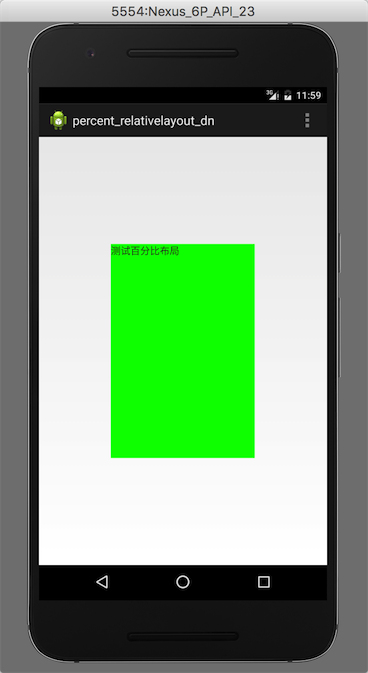android自定義View(2):實現百分比自適應佈局
android介面適配難是歷史原因,我們只能想辦法解決。github上面已有一些佈局自適應的解決方案,今天我分享的是自定義控制元件:RelativieLayout自適應百分比寬高。直接上菜。
一,實現的效果圖

眼見為實,截圖所示,寬高都是50%,實現了自適應
二,實現的原理
其實很簡單,就是自定義兩個屬性:寬和高的百分比,讓自定義的view繼承 RelativeLayout。取出這兩個屬性的值,測量父佈局的寬高,乘百分比就是實際的寬高,然後確定在父控制元件中的位置。
三,自定義樣式屬性
在values資料夾中新建attrs.xml,內容如下:
layout_widthPercent和layout_heightPercent都是浮點型,0-1之間的值,代表百分百。
<?xml version="1.0" encoding="utf-8"?>
<resources>
<declare-styleable name="percentRelativeLayout">
<attr name="layout_widthPercent" format="float"></attr>
<attr name="layout_heightPercent" format="float"></attr>
</declare-styleable>
</resources>四,自定義percentRelativeLayout
簡單粗暴,根據xml佈局中的子view的LayoutParams獲取實際寬高。
public class PercentRelativeLayout extends RelativeLayout{
public PercentRelativeLayout(Context context, AttributeSet attrs, int defStyleAttr) {
super(context, attrs, defStyleAttr);
// TODO Auto-generated constructor stub
}
public PercentRelativeLayout(Context context, AttributeSet attrs) {
super(context, attrs);
// TODO Auto-generated constructor stub
}
public PercentRelativeLayout(Context context) {
super(context);
// TODO Auto-generated constructor stub
}
@Override
public LayoutParams generateLayoutParams(AttributeSet attrs) {
// TODO Auto-generated method stub
return new LayoutParams(getContext(), attrs);
}
//測量自己
@Override
protected void onMeasure(int widthMeasureSpec, int heightMeasureSpec) {
//獲取自身的寬高
int widthHint = View.MeasureSpec.getSize(widthMeasureSpec);
int heightHint = View.MeasureSpec.getSize(heightMeasureSpec);
for(int i = 0;i<this.getChildCount();i++){
View child = this.getChildAt(i);
//獲取孩子view的佈局屬性
ViewGroup.LayoutParams params = child.getLayoutParams();
float widthPercent = 0;
float heightPercent = 0;
//含有自定義的屬性,則獲取百分百
if(params instanceof PercentRelativeLayout.LayoutParams){
widthPercent = ((PercentRelativeLayout.LayoutParams) params).getWidthPercent();
heightPercent = ((PercentRelativeLayout.LayoutParams) params).getHeightPercent();
}
if(widthPercent == 0|| heightPercent == 0){
continue;//百分百為0,跳出此次迴圈
}
//真實的寬高
params.width = (int) (widthPercent*widthHint);
params.height = (int) (heightPercent*heightHint);
}
super.onMeasure(widthMeasureSpec, heightMeasureSpec);
}
@Override
protected void onLayout(boolean changed, int l, int t, int r, int b) {
// TODO Auto-generated method stub
super.onLayout(changed, l, t, r, b);
}
public static class LayoutParams extends RelativeLayout.LayoutParams{
private float widthPercent;
private float heightPercent;
public float getWidthPercent() {
return widthPercent;
}
public void setWidthPercent(float widthPercent) {
this.widthPercent = widthPercent;
}
public float getHeightPercent() {
return heightPercent;
}
public void setHeightPercent(float heightPercent) {
this.heightPercent = heightPercent;
}
//建構函式裡面獲取自定義樣式屬性的值
public LayoutParams(Context c, AttributeSet attrs) {
super(c, attrs);
TypedArray array = c.obtainStyledAttributes(attrs, R.styleable.percentRelativeLayout);
widthPercent = array.getFloat(R.styleable.percentRelativeLayout_layout_widthPercent, widthPercent);
heightPercent = array.getFloat(R.styleable.percentRelativeLayout_layout_heightPercent,heightPercent);
array.recycle();
}
public LayoutParams(int w, int h) {
super(w, h);
// TODO Auto-generated constructor stub
}
public LayoutParams(android.view.ViewGroup.LayoutParams source) {
super(source);
// TODO Auto-generated constructor stub
}
public LayoutParams(MarginLayoutParams source) {
super(source);
// TODO Auto-generated constructor stub
}
}
}五,佈局中引用自定義View和屬性
上菜了。不用 系統控制元件,用我們們自己的。
<com.example.view.PercentRelativeLayout
xmlns:android="http://schemas.android.com/apk/res/android"
xmlns:app="http://schemas.android.com/apk/res/com.example.percent_relativelayout_dn"
android:layout_width="match_parent"
android:layout_height="match_parent">
<TextView
android:layout_width="wrap_content"
android:layout_height="wrap_content"
android:text="測試百分比佈局"
android:layout_centerInParent="true"
app:layout_widthPercent = "0.5"
app:layout_heightPercent = "0.5"
android:background="#00ff00"
android:id="@+id/textview"
/>
</com.example.view.PercentRelativeLayout>六,實現與總結
直接在activity中執行測試,是不是很完美了。寬高半分比佈局OK了。
public class MainActivity extends Activity {
@Override
protected void onCreate(Bundle savedInstanceState) {
super.onCreate(savedInstanceState);
setContentView(R.layout.activity_main);
}
}五大布局都可以實現,今天只是分享了RelativieLayout的中控制元件的百分百自適應。之前在github上面看了一個很全面的百分百佈局方案,其實原理就這樣。
歡迎交流,杜乾,Dusan,Q 291902259。
相關文章
- Android自定義View實現流式佈局(熱門標籤效果)AndroidView
- Android自定義View(四)側滑佈局AndroidView
- CSS佈局 --- 自適應佈局CSS
- 如何實現兩欄佈局,右側自適應?三欄佈局中間自適應呢?
- css佈局,左右固定中間自適應實現CSS
- css實現左欄固定右欄自適應,高度自適應的佈局CSS
- css自適應佈局CSS
- rem自適應佈局REM
- android 實現FlowLayout 流線佈局(自定義ViewGroup)AndroidView
- Android自定義view-自繪ViewAndroidView
- 三欄佈局之自適應佈局
- 利用@media screen實現網頁佈局的自適應網頁
- android 螢幕適配一:通過自定義View的方式實現適配AndroidView
- 三列自適應佈局(聖盃佈局)
- Android自定義View 百分比進度動畫AndroidView動畫
- Android 自定義氣泡佈局Android
- 構建Android自適應佈局應用方案解析Android
- objc系列譯文(3.3):自定義Collection View佈局OBJView
- 自定義View:畫布實現自定義View(折線圖的實現)View
- iPhone 6的自適應佈局iPhone
- 深入解析Android的自定義佈局Android
- css佈局之左側固定右側自適應佈局CSS
- lib-flexible 實現移動端自適應佈局Flex
- CSS Grid 網格佈局實現自適應9宮格CSS
- Android自定義View實現文字輪播效果AndroidView
- Android自定義view實現數字時鐘AndroidView
- 自定義View:自定義屬性(自定義按鈕實現)View
- android 螢幕適配二:手寫百分比佈局適配Android
- 3個自定義view佈局:矩形TextView,圓形進度條,圓環viewTextView
- Android自定義View:View(二)AndroidView
- 兩列自適應佈局方案整理
- 三列寬度自適應佈局
- display:table-cell自適應佈局
- easyui-layout佈局高度自適應UI
- css三列自適應佈局效果CSS
- 【HTML / CSS】使用position自適應佈局HTMLCSS
- Web自適應佈局那些事兒Web
- android自定義佈局——城市選擇介面Android